The Invention of Clumsiness
The hybrid provocations of Manet’s Déjeuner sur l’herbe
Alexi Worth
One afternoon in May of 1853, the painter Eugène Delacroix went for a walk in the forest with two old friends. As they walked, the three men returned to topics they had discussed before: questions of spontaneity, how finished pictures are “always somewhat spoiled” compared to sketches. Together they admired a famous oak tree. They talked about Racine. Then they went back to Delacroix’s house for dinner. After the meal, Delacroix later recalled, “I made them try the experiment which I had done myself, without planning it, two days before.” The experiment was simple. First, he passed around a set of unusual pictures, photographic calotypes that Eugène Durieu, a pioneer in the new medium of photography, had taken at his request.[1] In these small amber images, a naked man and woman appeared—sometimes alone, sometimes together; sitting, standing, or kneeling; often staring warily back at the lens. The naked couple are memorable to posterity, because they were among the first humans to be photographed without clothes. If they weren’t the Adam and Eve of photographic nakedness, they were among the earliest citizens of that now fairly populous realm. But they didn’t beguile or even impress the great painter and his companions. “Poorly built, and oddly shaped in places,” as Delacroix drily put it, the two models were “not very attractive generally.” After his friends had spent some time examining the calotypes, Delacroix asked them to look at a second set of pictures, ones that should have been much more appealing. These were engravings by Marcantonio Raimondi, the celebrated Renaissance printmaker whose compositions were based on designs by, among others, Raphael and Michelangelo. Delacroix’s experiment was in effect a beauty contest. When it came to depicting the body, how would the new “machine-art” fare against human skill? How would photographic nakedness compare to idealized nudity? The result was decisive and unsettling. Looking at the older nudes, Delacroix’s little group saw them with new eyes.
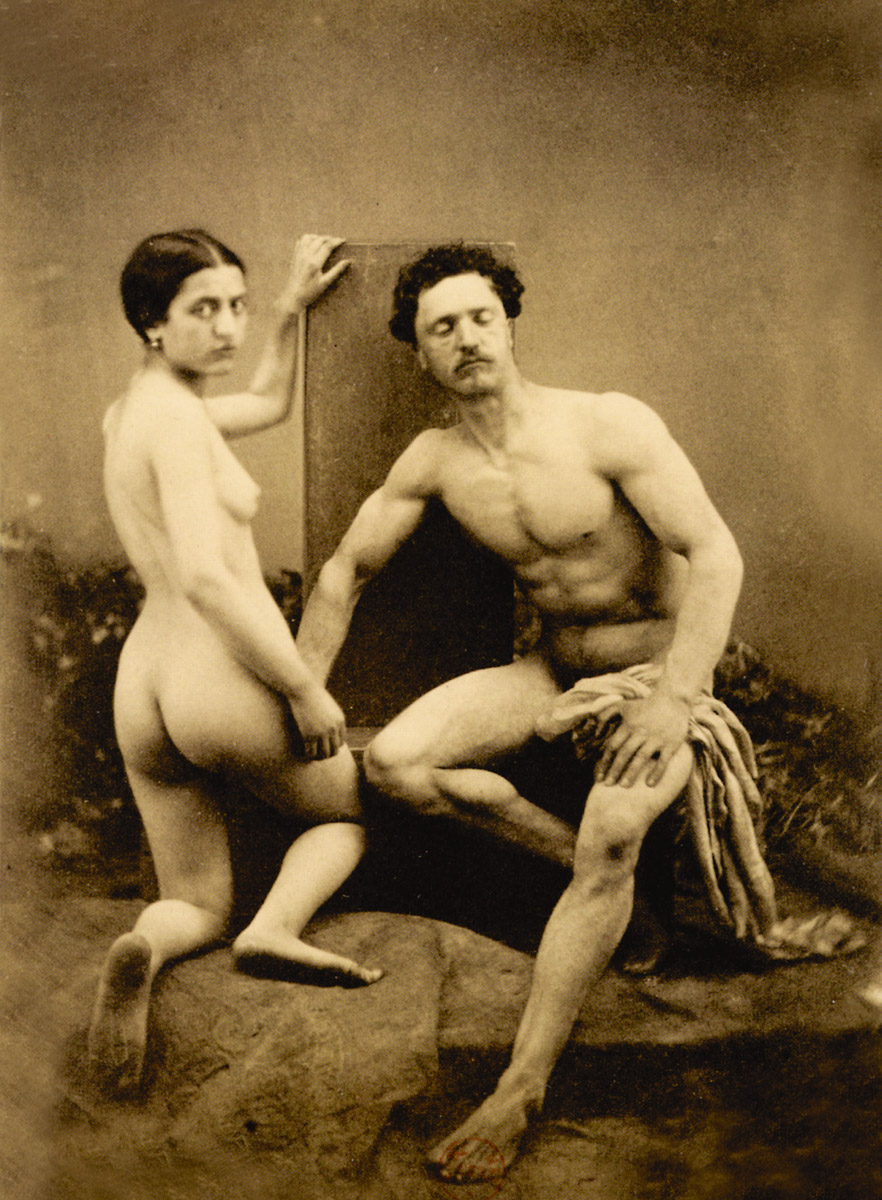
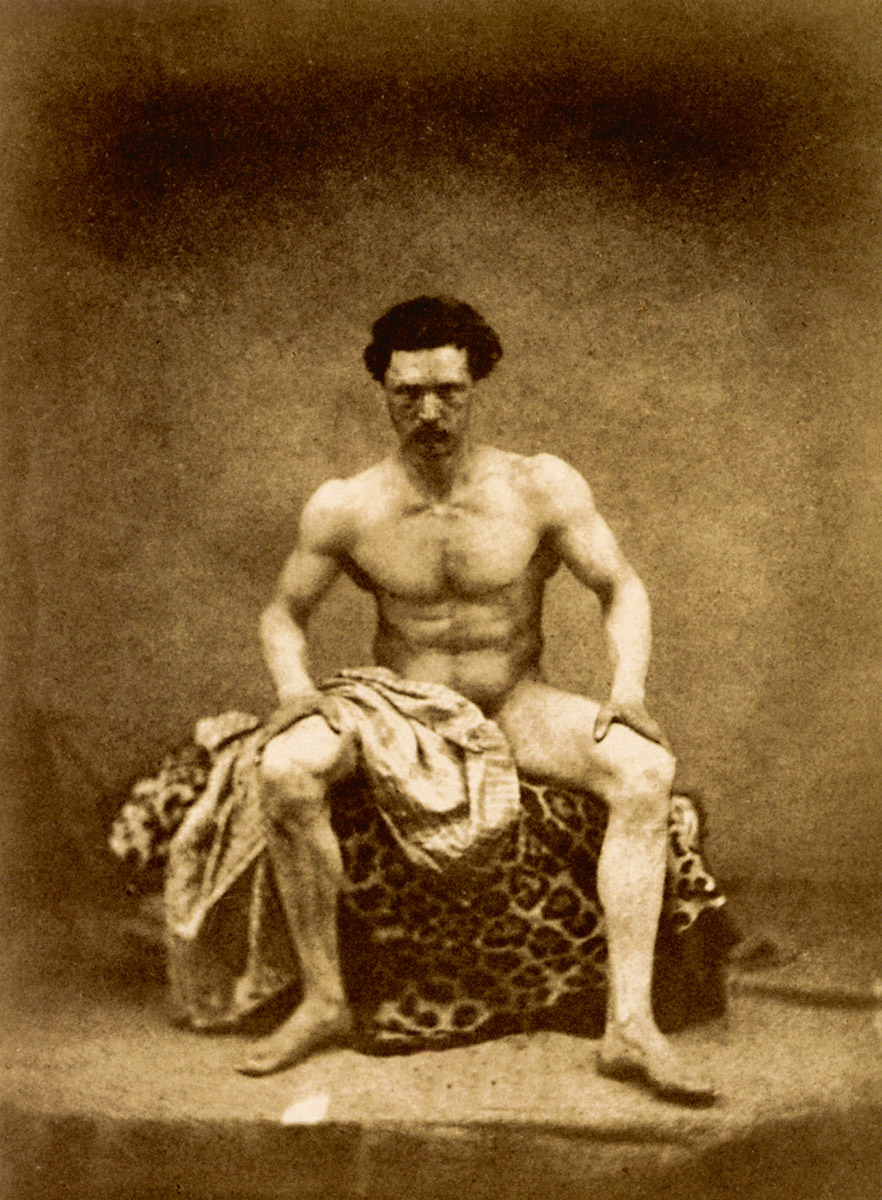
It’s possible to approximate Delacroix’s experiment today. Many of the photographs he and Durieu took together survive, along with drawings Delacroix made from them. To our eyes, the calotype couple—a dark-haired woman and a lean, muscular man—don’t seem especially unattractive or “oddly shaped.” Which is to say, it takes an effort to imagine what earlier eyes might have found unshapely. The thin, wedge-shape of her right foot? The sooty darkness of her buttocks, compared to her small bright torso? The strange way that the glowing ostrich egg of his calf muscle is accidentally isolated? Perhaps Delacroix and his guests were made uncomfortable by something else: the voyeuristic discomfort of being stared back at by these particular individuals, whose prickly selfhood had not been filtered through an intervening imagination. For our relatively jaded twenty-first-century eyes, however, none of this—neither odd bodies, nor lighting accidents, nor prickly, projected selfhood—feels novel. For us, the experiment may work best backward: only after spending some time with Marcantonio’s images, reaccustoming ourselves to their highly convention-bound proportions, can we begin to see the lost strangeness of the Delacroix-Durieu calotypes.
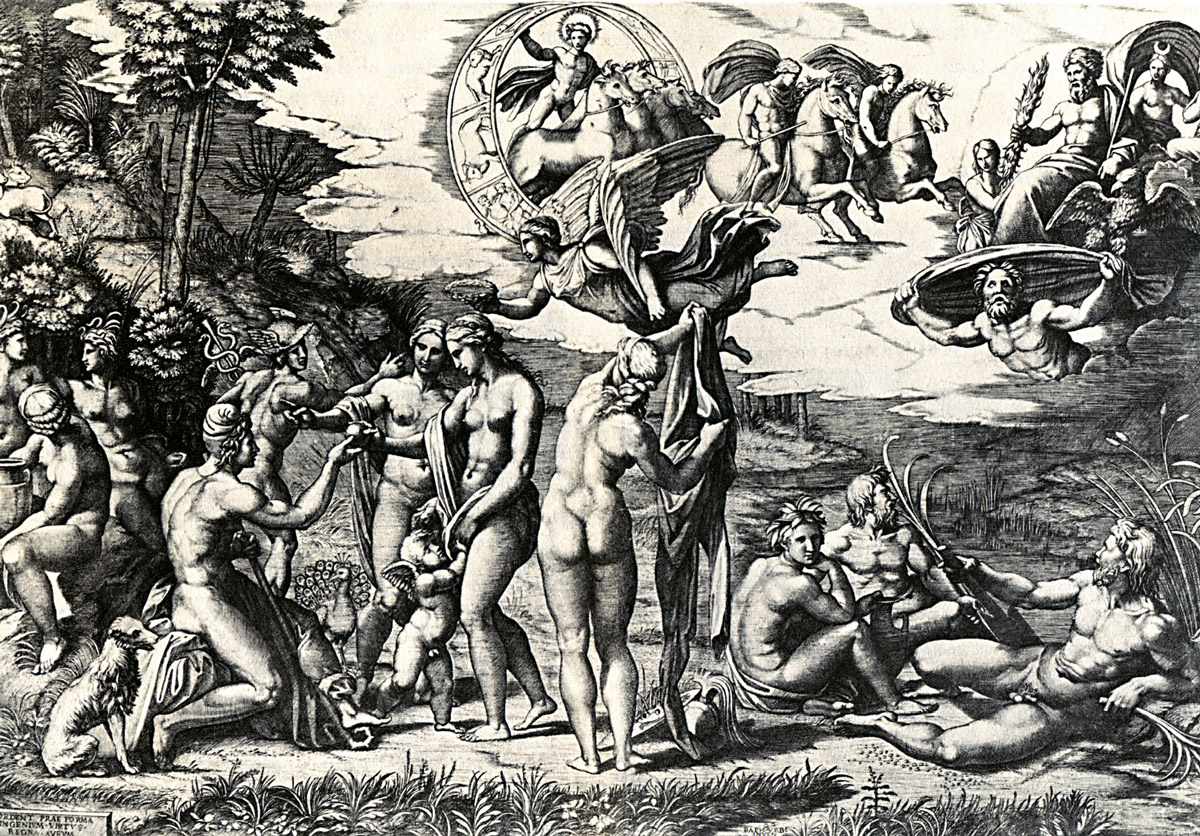
Unfortunately, in his journal Delacroix never says precisely which engravings he showed to his friends. Aaron Scharf, the historian who first wrote about Delacroix’s experiment, suggested Marcantonio’s Adam and Eve, which would make for a pleasantly neat set: two male-female couples. Another likely possibility is The Judgment of Paris, which would have had an ironic resonance. As the mythical Paris contemplates three nude goddesses, Delacroix’s friends were asked to judge two kinds of naked body: to choose the goddess of draftsmanship or the goddess of photography. And choose, in a sense, they did. Though none of Delacroix’s group seems to have much liked the photographs, they found after seeing them that the Marcantonios were transformed. No longer admirable, the engravings were clumsy, even grotesque. “We experienced,” Delacroix wrote in his journal,
a feeling of revulsion, almost disgust, for the incorrectness, the mannerism, the lack of naturalness, despite the quality of style—the only thing one could admire. Yet at that moment we could no longer admire it.
Those few words, recording a modest social occasion, also document a historical watershed: the moment when photographs defamiliarized the art of the past. Delacroix and his peers had grown up in an era when nakedness was memorialized by prints, drawings, and paintings. To their eyes, the look of photographed bodies seemed abnormal and unattractive. As of that evening though, so did Renaissance draftsmanship. Western visual culture was beginning its shift to new, less artisanal foundations. For an awkward transitional period, both new and old norms were insecure. Photography, as Delacroix put it, had begun by rendering a “detestable” service. “Without completely satisfying us,” he complained, “il nous gâte les chefs-d’oeuvre.” It spoils the masterpieces.
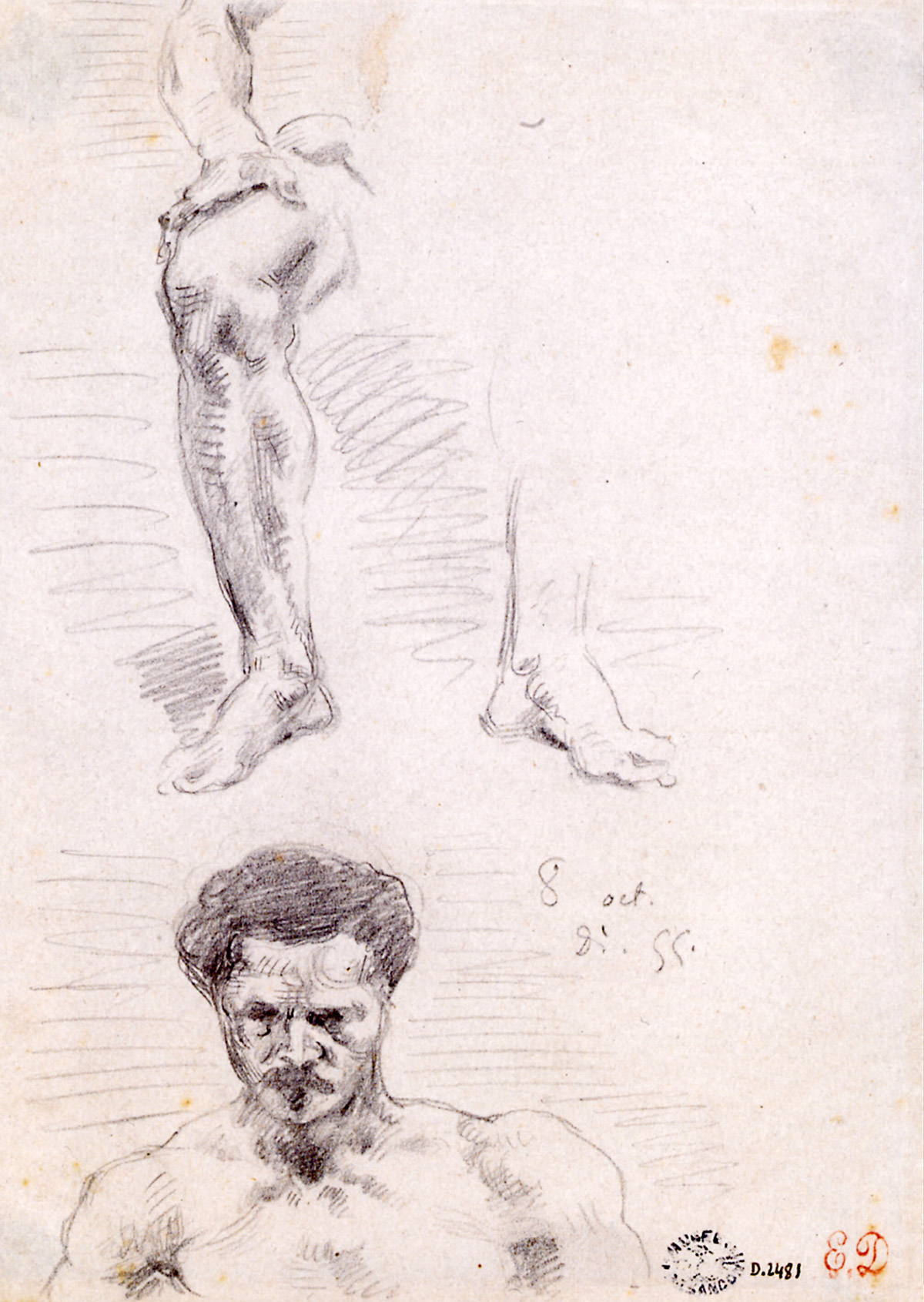
Almost two centuries later, we are apt to think of the birth of photography as initiating a long history of anxiety about painting’s future. For Delacroix, the opposite was true. The past was shadowed, but the future looked brighter than ever. In the following months, he would arrange more modeling sessions with Durieu, and eagerly make drawings from the results. He imagined that the daguerreotype (the term was then interchangeable with “photograph”) would contribute to a new and improved kind of painting, one he himself would not live to see. In his journal, he ended his account of the evening’s experiment with a confident glimpse into the future. “Truly, if a (painter) of genius should use the daguerreotype as it ought to be used,” Delacroix prophesized, “he will raise himself to heights unknown to us.”[2]
What kind of “heights” could Delacroix imagine? If future viewers shared the new, almost painful sensitivity to incorrectness, perhaps photography would become a sort of proofreading tool. The painters of the future would use it to eliminate the old faults and mannerisms, assimilating photography’s impressive objectivity—while, of course, steering clear of its potential unattractiveness. This kind of prudent assimilation would in fact soon become the hallmark of the next generation’s leading painters, people like Gérôme, Cabanel, and Meissonier in France, Millais in England, and Church in the United States. A bland accuracy, akin to photography in its finish and meticulous detail (but not in its frankness), paralleled the growing availability of photographs themselves. Some critics claimed that by 1859, “the majority of artists” were already working directly from daguerreotypes, “their most precious aid.”[3] We’ll never know if that’s entirely true, but it doesn’t matter. Whether or not they were drawing from them, most mid-century painters were looking over their shoulders at photographic effects. And we know that even a brief exposure could induce the sensitivity that Delacroix had first described, the disgust at pre-photographic errorfulness. What we now think of loosely as “academic painting” was the first broad response to this sensitivity.
This was painting’s future, but probably not the future Delacroix had in mind. Granted, he made many meticulous, quasi-academic drawings from Durieu’s nudes. But his sole Durieu-based painting looks very different. This small canvas, his Odalisque from 1857, evidently derives its lighting, pose, and proportions from a calotype—but not its Moroccan setting, hothouse color, and wavering, undulant contours. Transformed from studio to seraglio, the painted image looks sketchier, less precise, and less “correct” than its source. In short, it looks like a Delacroix—and Delacroix’s turbulent painterly manner, often faulted for its drawing errors, was as far from photography as it was from academic finesse. So Delacroix’s enthusiastic prophecy, his vision of a new painting empowered by the camera, represents something of a puzzle.
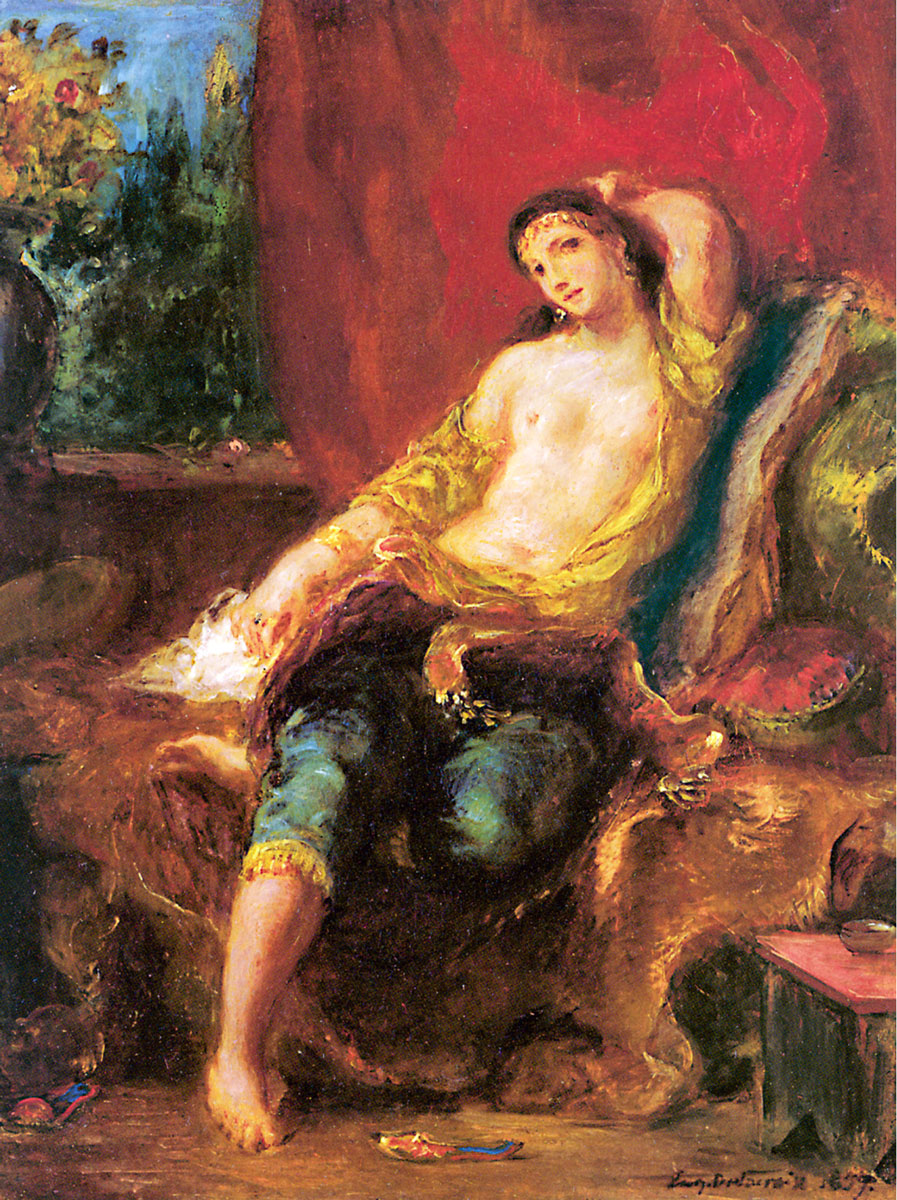
If not necessarily correctness, what did Delacroix think photography could offer painting? The best glimpse of his thinking comes in two short essays written toward the end of his life, in which the painter sets out nuanced, ambivalent ideas about photography. It’s clear that Delacroix loved the new technology’s dazzling naturalism, but not its overabundant detail. Again and again he mentions simplicity—a key term for Delacroix—as a quality good photographs lacked. There was something disagreeable about their “all the tiles on a roof” busyness, their lack of selectivity: “When a photographer takes a scene,” he protested, “the edge of the picture is as interesting as the center ... the subordinate parts as dominant as the main subject.” The most interesting photographs were slightly faulty ones, where “the imperfections of the process” leave lacunae, “rests for the eye.”[4]
Imagine yourself as an ambitious young Parisian artist in the 1850s. You belong to the first generation to have grown up with photography. At the same time, you revere Delacroix, and the imaginative, anti-academic idiom he represents. How would you reconcile the two? Judging by Delacroix’s own writings, the answer is clear: you would start from imperfect or faulty photographs. You would strip away overabundant detail. Your execution would be selective and uneven. In some areas, you might follow photographic proportions; in others you might be tolerant of incorrectness. In 1863, in the very year that Delacroix died, the Parisian public singled out a painting that embodied exactly these qualities, a painting whose imagery recalls, with strange specificity, the story of Delacroix’s experiment.
It’s odd that this painting, Edouard Manet’s Le Déjeuner sur l’herbe, which has tested our ingenuity for 150 years, has never been linked to Delacroix’s journal account. And yet Manet knew Delacroix, and also had links to the two friends, Léon Riesener and Jean-Baptiste Pierret, who were present that May evening.[5] The Déjeuner sets a visual paraphrase of Marcantonio’s Judgment of Paris in a forest, its lounging river gods transformed into a pair of male friends in contemporary dress. One of them seems to be pointing toward the disrobed woman across from him, as if the subject of their discussion was precisely the quality of her nakedness. And the quality of that nakedness is unusual.
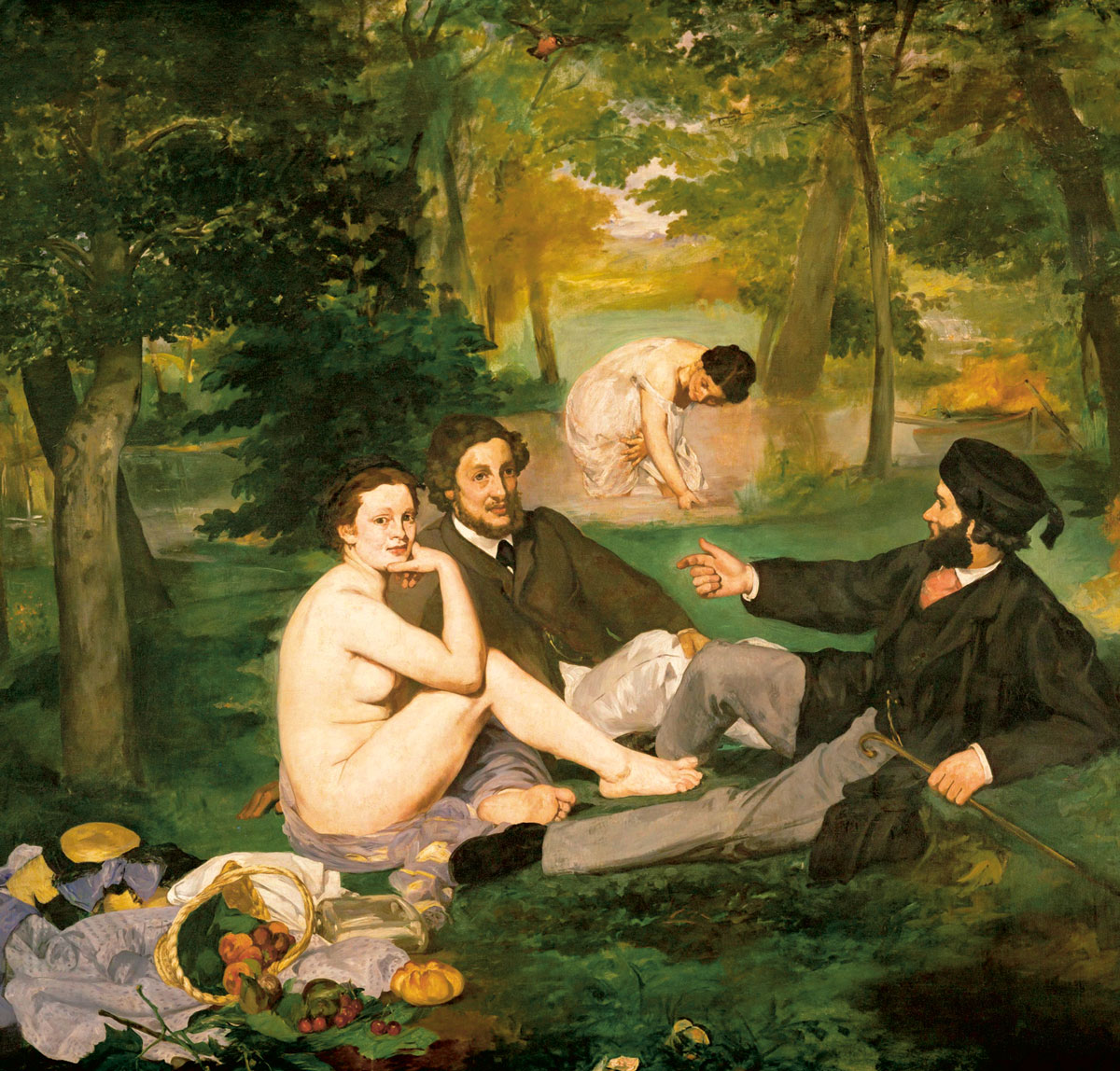
Today, her pale, slightly stocky body projects a kind of tact. Neither overly sexual nor distractingly homely, she has a frank dignity that is vastly preferable to the eroticism of so many Salon nudes. To Manet’s chagrin, most of his contemporaries did not see her that way. Even sympathetic critics lamented that “the nude hasn’t a good figure, unfortunately.”[6] Their response echoes Delacroix’s disappointment over the “poorly built” and “oddly shaped” models in the Durieu calotypes, whose bodies did not match pre-photographic conventions. There are other reasons to associate this female figure with photography: the precision of her stare; the unerring articulation of her body in space; and most of all the harsh, nearly shadowless light that illuminates her from the front, almost as if we ourselves, the viewers, were shining a spotlight at her. This kind of lighting has distinctive effects: it simplifies and flattens foregrounds while leaving backgrounds dark. Almost unprecedented in painting, such stark frontal lighting had in fact first made its appearance just a few years earlier in certain portraits by the great photographer Nadar, a friend of both Manet and Delacroix.[7]
Does this mean that Manet may have staged photographs, and worked directly from them? It’s a contentious subject, one many scholars have dismissed with special irritation, as if the idea were both implausible and belittling.[8] If he did work from his own Nadaresque photographs, however, Manet did not simply reproduce them. He invented a brusque new painterly facture, a distinctive stylization of a distinctive kind of photography. That combination, with its simplicity and brio, made his paintings look persuasively unphotographic, especially compared to the expectations of their time. But the buried presence of photography is something that we ourselves sense, at least intuitively, whenever we look at paintings like the Déjeuner and Olympia. It is not enough to say that there is something eerily contemporary about the presence of Manet’s model for these paintings, Victorine Meurent. Nakedness is always potentially timeless, but other nudes from the 1860s do not make these claims. What we recognize is a visual meme that we know from countless examples: the stark, flash-lit figure (actual flash lighting was not developed until after Manet’s death, but the effect of strong frontal lighting is equivalent). In Victorine, we recognize the distant ancestress of our own night snapshots, with their overexposed skin tones and narrow, contour-hugging shadows.
That recognition is puzzling, a quiet provocation lurking underneath the more blatant oddity of Victorine’s nakedness. What’s troubling is not her photographicity itself, but the way that it jars against the sketchy handling of her setting. Around Victorine (and her almost equally photographic male companions), crude tree trunks and foliage have been brushed in with a casual touch, creating distinctly thin, cartoony greenery. Since the Déjeuner was first displayed, this contrast—a “wholly inexplicable incoherence” between figures and setting—has irked viewers. But the contrast has never been seen in photographic terms, as subliminal multimedia friction: Nadaresque bodies set in a strongly unphotographic painterly glade. The Déjeuner, in other words, is a covert collage, an amalgam of photographic and traditional sources—including, no doubt, drawings, sketches, and, of course, Marcantonio’s engraving too. Of these sources, Marcantonio was the most public, the most likely to be recognized. For anyone in Delacroix’s circle, it might even have been a cue, a symbol of thinking about such frictions, a reminder of his 1853 experiment. Perhaps, having heard some version of the journal story, Manet set out to play with its premise, to see whether he could make the dissonance between Marcantonio and photography into more than just an experiment—into a picture.
To be sure, there are no surviving nude photographs of Victorine Meurent, no corroborating statements from Manet, nothing to prove the connection. Manet’s decision to use Marcantonio may be a coincidence.[9] But it’s clear, at least, that Manet was thinking along lines very close to Delacroix’s. The idea of a Delacroixian Déjeuner might do more than provide a fresh angle on an overstudied picture; it might in fact illuminate the relatively furtive early symbiosis of photography and painting. What would this mean? In other words, what would it mean to see Manet as consciously responding to the anxieties Delacroix articulated? First, it might soften our attitude toward Manet’s public, the perplexed and often hostile Parisian audience of 1863. For these viewers, as for Delacroix and his guests ten years earlier, the look of photographic bodies was still novel and uncomfortable. Hence their irritation with the image of Victorine, which many found not just unfortunate, but even “the ideal of ugliness.”[10] For other, presumably more photographically experienced spectators, Victorine was one of the few satisfying elements—one of the only passages, as the critic Théodore Pelloquet put it, “that come close to nature.”[11] (It’s telling that the first group phrased its dissatisfaction in terms of an “ideal,” the second in terms of “nature.”) Manet’s audience, in other words, was a mixed group, caught in a transition that the Déjeuner itself reflected. Whereas academic painting smoothed and eased the photographic transition, the Déjeuner did the opposite. The painting’s incoherent facture mirrored a discomfort Manet’s peers felt in their everyday lives, as they squinted at portrait photographs or reproductions of works of art, finding that neither looked quite satisfying.
Our eyes are different. We read the cursory trees, the flat painterliness, the willfulness of the whole amalgam, as a kind of prelude to Cézanne’s forests, Matisse’s gardens, and Picasso’s beaches. For us, it’s easy, perhaps too easy, to see Manet’s Déjeuner as a step into the future. But for Manet himself, the Déjeuner was as much about the past as the future, a past that was being threatened, even “spoiled,” by the new photographic sensitivity. In his own lifetime, photography was making the unevenness of earlier art problematic. Marcantonio’s engravings were revealed to be full of errors and mannerisms; presumably so were even greater works, the masterpieces by Titian, Rubens, Velázquez, Goya, and Watteau that Manet quoted so frequently during the 1860s. Historians have long puzzled over this odd practice, Manet’s persistent quotation of earlier art. At the same time, viewers have been puzzled by Manet’s strange facture, his palpable errors and frank inconsistency. In light of Delacroix’s thought, it seems clear that these were two facets of the same intent: a desire to reaffirm painting’s unevenness, to defend variability. “The grandeur of the Old Masters,” as Delacroix put it, “does not consist in the absence of faults.” Delacroix’s point was already polemical, but it was Manet who put that polemic into pictorial form. Seduced and empowered by photography, academic finish threatened to banish human clumsiness, seemingly forever. Manet’s response was not kneejerk intransigence—which might have meant adopting a uniformly sketchy romantic manner. Instead, by toggling toward and away from photography, he made his own waywardness look unmistakably deliberate, and new.
An earlier, shorter version of this essay appeared in The Figure (Skira/Rizzoli, 2014).
- The question of which Durieu images Delacroix showed his friends has been a subject of debate. Some scholars believe that the photographs shown that night are no longer extant, and that the images reproduced with this text are in fact not dated 1853 but are from a session with Durieu that Delacroix arranged in 1854. For more on the disputed dates of these photographs, see Bernard Marbot and Weston J. Naef, Masterworks of French Photography (1848–1900) from the Bibliothèque Nationale (New York: The Metropolitan Museum of Art, 1980), pp. 30–32.
- Eugène Delacroix, Journal 1822–1863 (Paris: Plon, 1980), p. 350. Most translations are from Walter Pach’s English edition, The Journal of Eugène Delacroix (New York: Covici, Friede, 1937), p. 314; a few are my own. The Durieu-Delacroix calotypes were recently reproduced in Christophe Leribault, ed., Delacroix et la photographie (Paris: Musée du Louvre, 2008).
- Ernest Chesneau quoted in Aaron Scharf, Art and Photography (London: Penguin, 1968), p. 137.
- Delacroix’s two essays are “De L’Enseignement du Dessin,” published in the Revue des Deux Mondes, 15 September 1850, and reprinted in Christophe Leribault, ed., Delacroix et la photographie, pp. 153–155; and “Réalisme et Idéalisme,” unpublished, collected in Eugène Delacroix, Oeuvres Littéraires (Paris: Crès & Cie, 1923), pp. 57–68.
- Riesener, a painter and Delacroix’s cousin, rented his house in Beuzeval to Manet’s friends the Morisots in the summer of 1864. Jean-Baptiste Pierret’s daughter Marie, who was Delacroix’s goddaughter, met her husband Champfleury at Manet’s home.
- Théophile Thoré, quoted in George Heard Hamilton, Manet and His Critics (New York: W. W. Norton & Company, 1969), p. 50.
- Nadar’s frontal lighting appears in the famous sequence of Pierrot images and in his self-portrait taken with artificial lighting, reproduced in Maria Morris Hambourg, Françoise Heilbrun, and Philippe Néagu, eds., Nadar (New York: The Metropolitan Museum of Art, 1995), plates 7–20, and p. 51.
- The best-known argument against photographic inference is Kirk Varnedoe, “The Artifice of Candor: Impressionism and Photography Reconsidered,” Art in America, vol. 68, no. 1 (January 1980). Among the writers who have explored the possibility of Manet’s working directly from photographs are Aaron Scharf, Beatrice Farwell, Michael Fried, Elizabeth Anne McCauley, Jean Clay, Larry Ligo, and myself.
- And yet, as Beatrice Farwell points out, The Judgment of Paris wasn’t the only Marcantonio that Manet adapted in 1862. Mademoiselle Victorine in the Costume of an Espada is likely based on Marcantonio’s Temperance. On the other hand, some scholars propose that Courbet paraphrased figures from Marcantonio’s Judgment of Paris even before Manet did, suggesting that Manet’s use of Marcantonio could have been a nod to Courbet rather than Delacroix—or, concievably, to both artists. See Beatrice Farwell, “Manet’s ‘Espada’ and Marcantonio,” Metropolitan Museum Journal, vol. 2 (1969), pp. 197–207, and Françoise Cachin, Charles S. Moffett, and Juliet Wilson Bareau, eds. Manet 1832–1883 (New York: Metropolitan Museum of Art, 1983).
- “Ideal of ugliness” was a phrase that appeared in Le Siècle on 19 July 1863; quoted in Ross King, The Judgment of Paris (New York: Walker Publishing Company, 2006), p. 88.
- Théodore Pelloquet, quoted in Michael Fried, Manet’s Modernism (Chicago: University of Chicago Press, 1996), p. 305.
Alexi Worth is a Brooklyn-based painter who has written for Artforum, the New Yorker, T, and other magazines. He is represented by DC Moore Gallery, New York, where his next show is scheduled to open in March 2015.
Spotted an error? Email us at corrections at cabinetmagazine dot org.
If you’ve enjoyed the free articles that we offer on our site, please consider subscribing to our nonprofit magazine. You get twelve online issues and unlimited access to all our archives.